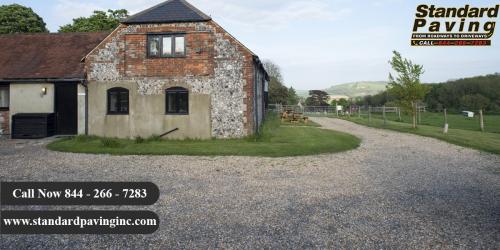Planning Guide for Designing a New Driveway

If
you are considering installing a new driveway or replacing one, a little prior
planning can make a huge difference in the performance and increased property
value you end up with. Planning a driveway isn’t rocket science, but for the
average homeowner, it’s something you may only do once or twice in a lifetime.
Taking into consideration the drive’s design can result in a much more
satisfying experience the main purpose of a driveway
paving company is
utilitarian, providing a way to get from the street to the garage, but there is
no denying the impact it has on the value of your property.
A driveway
doesn’t have to be just a way to get from the street to the garage.
Before You Start, Think About This
Slope
and Width: Generally
speaking, you have to work with the terrain you have. Ideally, the slope of
your driveway should be 15% or less meaning your drive should drop 15 feet or
less over 100 feet. That said, a flat driveway can be just as problematic as a
steep drive. Flat drives can create drainage issues particularly if you have a
nonporous surface like concrete or pavers. If your front lawn is flat, you want
to be certain that the contractor constructs a crown in the center of the drive
to allow rain to run off. Further, you want to make sure that runoff doesn’t
create its own problem and provide for adequate drainage.
Steep
driveways have the obvious problem of creating dangerous, slippery surfaces in
inclement weather. In extreme circumstances, switchbacks may be required to
bring the slope into a manageable range. If that’s required, the curves in the
switchback should be wider than the straight runs to accommodate for over and
under steering.
As
a general rule, driveways are 10 to 12 feet wide. Then there’s the area where
the drive meets the garage. If you have the space, add an “apron” (12 feet x 18
feet or larger) to allow for turning around or to be used for additional
parking space.
Curved,
Circular, or Straight? If
your garage is a short distance from the street, then the straight shot approach
is your best option. Just because it’s straight, it doesn’t have to be boring.
Its appearance will depend significantly on which paving material you select,
gravel, asphalt, concrete, or pavers. But it doesn’t have to end there. All
four of those materials can be enhanced with color and patterns and of course a
decorative border doesn’t care what design the driveway is.
If
you have the room in your front lawn, a curved drive can add a great deal of
character to the property. A curved driveway paving contractor can also solve the problem of trees or
landscape features that block direct access to the garage, or if your street
access point doesn’t line up with the garage. If you use curves, be certain to
make them sweeping and avoid tight curves.
Circular
drives can be one of the most effective sales feature a house has if it’s
located on a busy street. Nobody wants to back out onto a road that has heavy
traffic. On the other hand, a circular driveway takes up a lot of real estate.
They also require a second access point (exit) to the street. If a second
access point isn’t an option, a “teardrop” drive can still give you the ability
to pull out in traffic as opposed to backing out. Teardrop driveways start out
straight then become a “circular drive.”
Permits:
Before you start your
perfectly planned driveway, check with the city and county to see if any
permits are required. You may have to create a new access point which means
you’ll also probably be crossing an easement. Don’t make the mistake of
starting this project only to have it shut down by a municipal inspector.
There’s
more to planning a driveway but this guide gets you pointed in the right
direction. Establishing a budget, selecting a paving material, and finding a
reputable, experienced paving contractor are your next challenges.






Comments